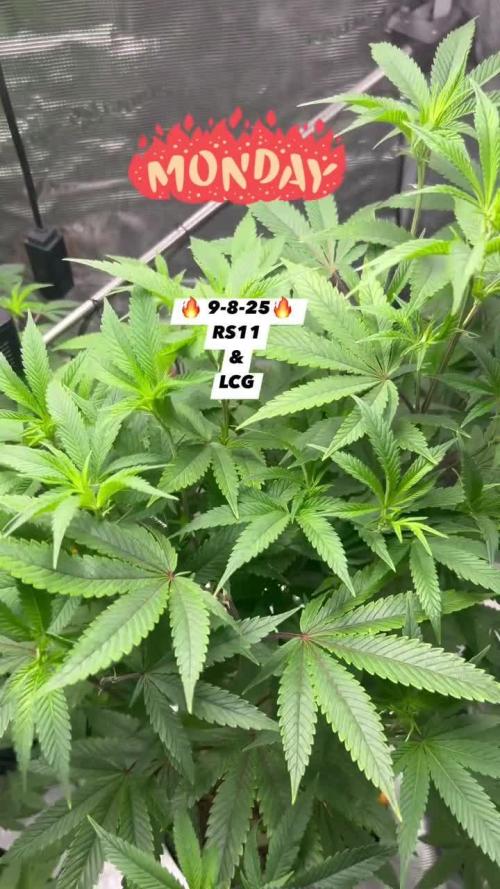The Grow Awards 2026 🏆 





















Likes
12
Share


@thonhash
Follow
Acabamos con estas colombian jack,con 70 días y un olor súper dulce,empezamos con el secado.
Likes
27
Share


@RDWCGrowing
Follow
4/10/2023
Week 1- Day 1 of Flower (Day 68 overall)
So when I looked in the tent today the leaves were just above the Net.
They hit my " I have to flip mark" so I did just that I flipped them today. I drained the system and filled it with Week 1 Day 1 Flower Nutes. The lights are set to turn off at 8:00pm EST and will turn back on tomorrow at 0800 EST and everyday for the rest of the Grow.
To get my water change schedule back on track to Saturdays, since I had to flip tonight on a Tuesday, I will wait 1 week and 5 days instead of the typical 2 weeks for my first change out of the system, so not this Saturday coming up but the following Saturday.
I added 36 Gallons of Water
Mammoth Silica = .5Mil/Gal= 18Mil
Root DRIP = 1Mil/Gal= 36Mil
CalMag= .5Mil/Gal= 18Mil
FloraMicro = 5.2Mil/Gal= 187Mil
FloraGro= 4.3Mil/Gal= 155Mil
FLoraBloom= 5.2Mil/Gal= 187Mil
TPS SIGNAL= 1.0Mil/Gal= 36Mil
ORCA = .5Mil/Gal= 18Mil
PPFD= 680
Water Temp= 71.4
Tent Temp= 77
Humidity =59
4/11/2023
Week 1- Day 2 of Flower (Day 69 overall)
Nothing to report day of rest of me and the plants as they get used to the flowering mix and the new lighting schedule.
4/12/2023
Week 1- Day 3 of Flower (Day 70 overall)
Heavy De-foliation was necessary.. A few branches are close to where I can SCROG them down.
4/13/2023
Week 1- Day 4 of Flower (Day 71 overall)
Super Cropped it and SCROGed it down to the net, I will keep and eye on it and take action as different branches reach over the line.
4/14/2023
Week 1- Day 5 of Flower (Day 72 overall)
I defoliated the canopy some and I cleaned up some of the under bruch that was getting no light. Deep in the middle and low under the canopy. I also did a little Super Cropping of any branches too far above the canopy.
4/15/2023
Week 1- Day 6 of Flower (Day 73 overall)
Continued defoliation of the top bottom and front and some heavy defoliation of the backs of the plants today..
4/16/2023
Week 1 - Day 7 of Flower (Day 74 overall)
Did Some Heavy Defoliation of the stuff on the inside that isn't getting any light and I cut off anything that I found that seems weak and is still just not making it to the canopy. I also did some super Cropping of the branches as well SCROGing it down. I added 10 gallons of water to they system the ladies have been thirsty and I added additional Week 1 Flower Nutes to the mix.
10 Gallons Add
Mammoth=.5mil/Gal= Weekly TOP UP + 10 Gallons Add
TOP UP= 36 Gallons = 18Mil
+10 Gallons = 5Mil
Total= 23Mil
Root Drip= 1Mil/Gal= 10Mil
CalMag=.5Mil/Gal = 5Mil
FloraMicro= 5.2Mil/Gal = 52Mil
FloraGro = 4.3Mil/Gal = 43Mil
Flora Bloom = 5.2Mil/Gal = 52Mil
TPS Signal = 1Mil/Gal = 10Mil
ORCA = .5Mil/Gal = 5Mil
PPM = 721
Likes
75
Share


@Secretflower
Follow
Bonjour mes amis,
💨 Le 18 Mai..Jour N°98 💨
🌻 Flowering Day 33 🌻
5ème semaine de floraison pour mes trois Original Glue Feminisées..
Franchement en une semaine c'est abusé comment les buds ont grandi.
Cette génétique c'est de la balle..
Ça commence à sentir très bon..😘
💉 : je ne change rien..👍
🔦 : Quantum Board 480 watts à 100% de puissance et à 40 cm de la canopé.
www.weedseedsexpress.com
Voilà c'est tout pour l'instant mes amis, merci beaucoup d'être passé voir mes chéries, hésitez pas à Sub et je vous suivrai en retour.
Prenez soin de vous et de vos proches.
Je vous souhaite que du bonheur avec vos plantes..😘
À bientôt..💨💨
Likes
10
Share


@Mo_Powers
Follow
not much happened this week. there was a lot of sunshine. a few stormy days and some rain. she is still doing well and growing steadily. she gets some biobizz bio
-bloom now.
Likes
19
Share


@MaxMo8
Follow
I transferred it to a half-gallon pot and I mixed the organic fertilizer with the soil.
Likes
16
Share


@Foggedaboudit
Follow
The tallest, densest, frostiest in the tent but the smell is less pronounced.
Likes
37
Share


@GreenHouseLab
Follow
5 Days into flower got some of Natty’s Root Seed Co lineup running. Selected 3 Runtz x Cereal Milk, 1 Apple Fritter x Thin Mint and 1 Natty’s Kush x Thin Mint, the real Thin Mint.
Day 7 Hard Strip
Likes
4
Share


@adam_pawloski87
Follow
@twenty20Mendocino R&DUpdate ~ Let’s Go day 49 for these girls an we are looking beautiful! This week we gave them another trim up a tied them down more a today they have bounced back like nothing happened, strong ones they gonna be an so nice an healthy!
The Sangria is looking really beautiful, she’s Been flowering for lil over 2 weeks now so we still got a good amount of weeks for her to build a little more but she is already looking amazing, can’t wait for her to be done, smelling delicious! Hope you all enjoy an have an amazing productive day as well as a great safe weekend! Peace love positive vibes to all y’all Cheers 😶🌫️💨💨💨💨🤙🏻
Likes
22
Share


@MonsieurDeLaRuche
Follow
F29: really my best grow since I started.. no deficiencies from the beginning to today!
the smells are more and more crazy, the trichomes more and more numerous
I will do a last defoliation in the week and I will not touch again until the end!
the plants that have herm are in front, for a week I haven't seen any bananas I'm happy
smell:
- code red #1: ripe strawberry and cream
- code red #2: fresh tangy strawberry
- Papaya bb #1: rotten exotic fruits, pineapple mango
- papaya bb #2: bubblegum, exotic fruit candies
- B45: citrus and bug on an exotic fruit background
- Cherry gar see ya clone: a puree of exotic fruits, pineapple in particular
- White runtz x Hollywood: lemon, fresh, bergamot
both LA vanilla cake, cream but very little marked yet
in my flowering TCO, I put:
- kelp hydrolysate
- epsom salt
- bat guano
- mealworm guana
- castor bean shell ash
- palm ash
- vermicompost
- blackstrap molasses
- elycitor
-Yeasts Saccharomyces Cerevisiae
Bottom right: Papaya Bang Bang #1
Bottom middle: LA Vanilla cake #2
Bottom left: Papaya bang bang #2
middle right: Code red #2
middle: cherry gar see ya #4 clone
middle left: White runtz x Hollywood
Top right: Code red #1
Top middle: B-45
Top left: LA Vanilla Cake #1
Likes
21
Share


@Chubbs
Follow
420 Fastbuds Week 1
Amnesia Zkittlez Auto
Woo hoo got to love when you do your weekly updates and the girls have doubled in size. This early stage of Veg is very exciting as you can really see the growth. They have good color with no signs of any issues so will keep up with the routine.
All in all Happy Growing
Likes
24
Share


@CanarianGrow92
Follow
This girl smells really good 😁 but i didn't expected less from this strain, i already tried several strains from fastbuds and they are all great.
This week i started to give some extra PK apart from the typical bloom nutrients, i expect this girl to finish all covered in tricomes, we can see already quite some tricomes everywhere and its only the 4th week of flowering, i hope that the weather stays good 😊👍





































